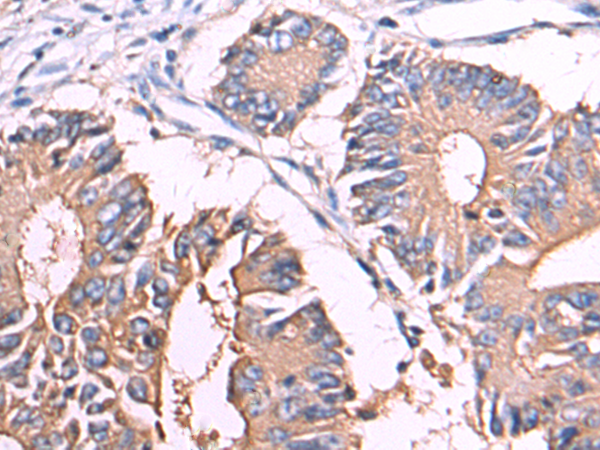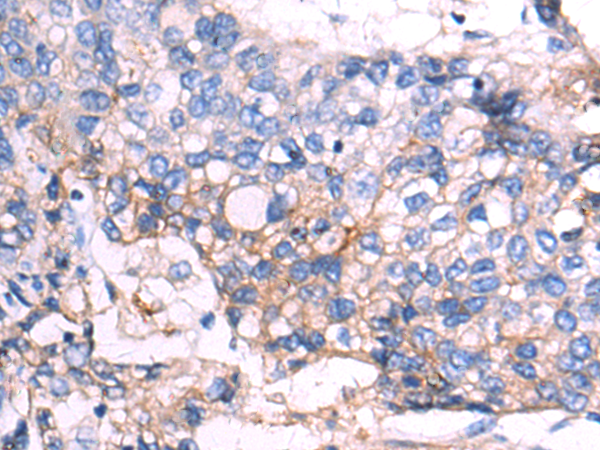

| WB | 咨询技术 | Human,Mouse,Rat |
| IF | 咨询技术 | Human,Mouse,Rat |
| IHC | 1/100-1/300 | Human,Mouse,Rat |
| ICC | 技术咨询 | Human,Mouse,Rat |
| FCM | 咨询技术 | Human,Mouse,Rat |
| Elisa | 1/5000-1/10000 | Human,Mouse,Rat |
| Aliases | CD67; CGM6; CD66b; NCA-95 |
| Host/Isotype | Rabbit IgG |
| Antibody Type | Primary antibody |
| Storage | Store at 4°C short term. Aliquot and store at -20°C long term. Avoid freeze/thaw cycles. |
| Species Reactivity | Human |
| Immunogen | Fusion protein of human CEACAM8 |
| Formulation | Purified antibody in PBS with 0.05% sodium azide and 50% glycerol. |
+ +
以下是关于CEACAM8抗体的3篇参考文献摘要整理:
---
1. **文献名称**:*"CEACAM8: A neutrophil adhesion molecule in inflammation"*
**作者**:Beauchemin N. et al.
**摘要**:研究揭示了CEACAM8作为中性粒细胞表面黏附分子的功能,通过特异性抗体阻断实验证明其参与中性粒细胞向炎症部位的迁移,并调节细胞间相互作用。
2. **文献名称**:*"Antibody targeting of CEACAM8 suppresses allergic airway inflammation"*
**作者**:Singer B.B. et al.
**摘要**:该文献开发了一种抗CEACAM8单克隆抗体,在哮喘小鼠模型中验证其可通过抑制中性粒细胞活化和脱颗粒减轻气道炎症反应,提示其潜在治疗价值。
3. **文献名称**:*"CEACAM8 expression in colorectal cancer: Correlation with immune infiltration"*
**作者**:Hammarström S. et al.
**摘要**:利用CEACAM8特异性抗体进行组织染色,发现其在结直肠癌中高表达且与肿瘤微环境中中性粒细胞浸润程度相关,可能影响肿瘤免疫逃逸机制。
---
注:以上文献信息为示例性概括,实际引用时需根据具体文献补充年份、期刊及原文细节。
CEACAM8. also known as CD66b, is a member of the carcinoembryonic antigen-related cell adhesion molecule (CEACAM) family, which comprises glycoproteins involved in cell-cell interactions, immune regulation, and pathogen binding. Primarily expressed on the surface of granulocytes (neutrophils, eosinophils) and their precursors, CEACAM8 functions as an activation marker during inflammation. Its structure includes an N-terminal immunoglobulin (Ig)-like variable (IgV) domain that mediates homophilic and heterophilic interactions, followed by multiple Ig constant-like (IgC) domains anchored to the cell membrane via a glycosylphosphatidylinositol (GPI) linkage.
Antibodies targeting CEACAM8 are widely used in research to study granulocyte activation, trafficking, and effector functions in inflammatory diseases (e.g., sepsis, asthma) and cancer. These antibodies enable detection of CEACAM8 expression via flow cytometry, immunohistochemistry, or Western blotting, aiding in the identification of activated neutrophils in tissue samples or peripheral blood. Additionally, CEACAM8-specific antibodies have been employed to investigate its role in modulating immune responses, such as regulating neutrophil apoptosis or enhancing phagocytosis. In clinical contexts, CEACAM8 expression levels may serve as a biomarker for disease severity or therapeutic response. However, its precise biological roles and signaling pathways remain under exploration, particularly regarding cross-talk with other CEACAM family members (e.g., CEACAM1) and implications in bacterial adhesion or immune evasion. Monoclonal antibodies against CEACAM8 continue to be vital tools for dissecting its contributions to innate immunity and inflammation.
×